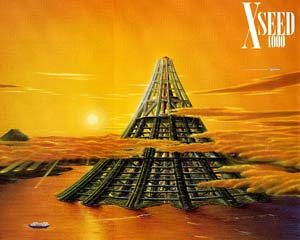Skyscraper enthusiasts who thought that the Japanese are beginning construction on “X-Seed 4000,” an 800-story building envisioned by Taisei Construction Corporation, will be disappointed to learn that the project is nowhere near execution—despite recent reports that suggested otherwise.

Contrary to recent rumors, Taisei has no plans to begin construction on the 4,000-meter-tall “X-Seed 4000” building.
“It was never meant to be built,” says Georges Binder, managing director of Buildings & Data, which compiles data on buildings worldwide. “The purpose of the plan was to earn some recognition for the firm, and it worked.”
Taisei conceived X-Seed 4000, a building 4,000 meters high, during the 1990s. At its base in Tokyo’s harbor, the super-tall skyscraper would span more than two square miles. A circle of wide, habitable pillars would house more than a half-million people in 750 million square feet of residential and office space. These pillars would support a soaring, teepee-like frame reaching a height of 13,123 feet at its “peak”—some 700 feet taller than Japan’s Mount Fuji, whose profile reportedly inspired the building’s shape. Environmental control systems would need to account for changes in atmospheric pressure and wind speed at higher altitudes.
Speculation that Taisei was moving forward with X-Seed began on August 20, when InHabitat.com contributor Kate Andrews wrote a blog about the rivalry between the Sears Tower and Taipei 101 for the status of the world’s tallest building. X-Seed, she wrote, could beat them both—not to mention the world’s current tallest building, Burj Dubai. Although Andrews noted that X-Seed was unlikely to move forward, the story exploded on the Internet and morphed into an urban legend. Within three days, dozens of reputable sites, including SciFi.com, reported that X-Seed could soon be underway. The project even earned a spot in the Council on Tall Buildings and Urban Habitat’s newsletter.
But RECORD has confirmed that reports of impending construction are simply tall tales. “(X-Seed) is on the shelf now,” says Shohei Ogawa, a manager in the planning department of Taisei’s international division. “It was our dream proposal for the technological advances we thought could happen in the future.”
These advances are not as far off as they might seem. “From an engineering point of view, most spans and heights are possible,” observes Eric Howeler, an architect and author of Skyscraper: Vertical Now. But “feasibility,” he adds, presents a serious obstacle. Securing the necessary financing, which by some estimates could exceed more than $1 trillion dollars, would prove difficult—not to mention obtaining the permits to build a structure of such magnitude, since few people would likely want a two-mile high skyscraper for a neighbor. “Tall buildings create a downdraft at their bases, and cast long shadows,” Howeler says.
One of the most daunting problems, adds Carol Willis, director of the Skyscraper Museum in New York City, is to make so massive a structure convenient to navigate for the people inside. Indeed, as one reader on AcceleratingFuture.com wondered, how long would a person on the 800th floor need to wait for an elevator?



Post a comment to this article
Report Abusive Comment